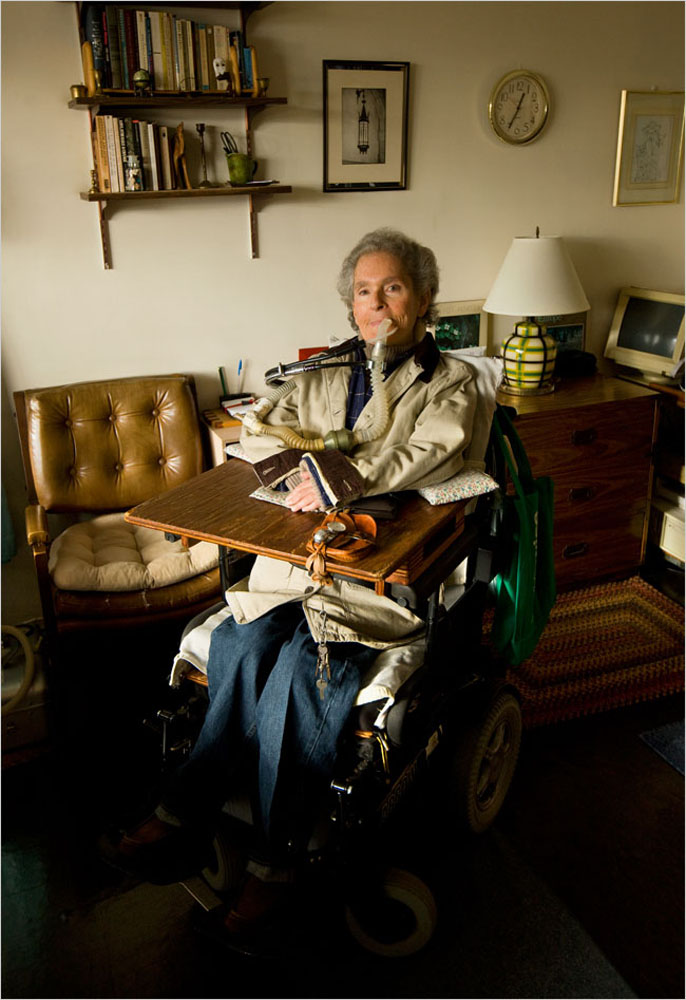The New York Times, 26 January 2009
Polio may seem like a distant memory. But thousands of people still live with the effects of the disease every day. And many are only in their 60s.
One of them is Sharon Stern. In 1954, at age 9, she developed the dreaded “summer plague.” Although she experienced some recovery early on, she has had no use of her four limbs ever since. Unless you happened to visit an enclave of several dozen disabled people on Roosevelt Island in New York City, you would never meet her.
I first met Ms. Stern, the cousin of a friend, in the lobby of her apartment building. She had steel-gray hair with bright eyes, and was carefully wrapped into her electric wheelchair.
The wheelchair contained a portable respirator, connected by a tube to a mouthpiece. Most people take breathing for granted. But while awake, Ms. Stern must continually create a seal with her lips on the mouthpiece to receive air. At 12 times a minute, 16 hours a day for more than 50 years, that is a lot of effort. (A tight mouth seal enables her to sleep safely).
Ms. Stern’s polio narrative is familiar. She was a healthy girl until she developed a severe headache. A doctor performed a spinal tap on the family’s kitchen table.
Her parents took her to a Brooklyn hospital, but her paralysis spread. When she began to have trouble breathing, a sign of severe bulbar polio, she was taken by ambulance to another hospital. There she was placed into the machine alternately praised as a lifesaver or condemned as a “steel casket”: the iron lung.
Except for their heads, patients were encompassed within iron lungs. Using changes in air pressure, the machines breathed for the patients, basically moving their paralyzed respiratory muscles. Portholes provided access to patients’ bodies.
But the portholes were a mixed blessing. It was not uncommon for the seals to loosen, causing them to fall open; that allowed outside air to enter and stop the iron lungs from working.
Unable to get air, patients could not call for help. Ms. Stern recalls several times when — probably turning blue from lack of oxygen — she finally got the attention of a passerby who fixed the machine.
Some children could not be saved. When a young girl in her ward died, Ms. Stern remembers being terrified of telling her parents: she thought they would expect her to die, too. The death haunted her for years, especially when she heard the song “The Darktown Strutters’ Ball,” which the girl’s father often sang to his daughter.
When it became clear that Sharon’s case would not reverse quickly, she was moved to Goldwater Hospital on Welfare Island (now Roosevelt Island). There she began a grueling program of physical therapy aimed at restoring her ability to walk and breathe on her own.
Neither of those goals was met. One day at age 11, she realized she would never ride her bicycle again. She remembers how she cried.
But there were other goals. The philosophy of Goldwater’s polio ward and its sponsoring organization, the National Foundation for Infantile Paralysis, was uplifting: “No matter how physically disabled we were, we could do anything in life.” By 1957 Sharon had left the iron lung, able to use less restrictive breathing devices that could be mounted on a wheelchair.
Aside from an 18-month period at home, she spent her teenage years at Goldwater. The staff, busy with rehabilitation, often neglected other things. “Teenage sexuality was ignored in the hospital,” Ms. Stern told me, “although it was very much on our minds.”
Nevertheless, there were high jinks. Once, someone was able to smuggle some wine onto the ward. Ms. Stern was out of the iron lung by then, but the nurse put her back in temporarily to ensure that her tipsy young patient did not stop breathing.
Ms. Stern left Goldwater in 1976, moving into an apartment in a building designed for people with polio and other disabilities. That year she also earned a bachelor’s degree in English from Empire State College. She has tutored children and adults in reading and math, and written more than 1,000 poems.
Still, when pressed, Ms. Stern acknowledges feeling “battered by life.” Most of her friends have died or moved away. And it is hard to find and hire aides, who must be available for her around the clock.
Since the passage of the Americans With Disabilities Act in 1990, perhaps the most public face of disability was that of Christopher Reeve. He represented the patient-activist, fighting the system and crusading for research.
But most physically disabled people live quiet lives, striving for normalcy and deriving meaning and pleasure from their accomplishments. Thus, Ms. Stern shuns terms like victim, survivor and physically challenged, referring to herself not by what she cannot do but by what she does: “I’m a poet, a tutor, a client of the home care agency and an employer of my staff.”
